Snapdragon 800 (MSM8974) Performance Preview: Qualcomm Mobile Development Tablet Tested
by Brian Klug on June 18, 2013 8:00 PM ESTCPU Performance
The state of CPU performance testing under Android is unfortunately still quite broken. We're using a mix of browser based tests with Java & Native apps (AndEBench).
The key comparisons to look for are the Snapdragon 800 MDP/T vs. the Exynos 5 Octa (4 x ARM Cortex A15s) based Galaxy S 4 (SHVE300S), the Exynos 5 Dual (2 x ARM Cortex A15s) based Nexus 10 tablet and any of the Snapdragon 600 based smartphones (HTC One/T-Mobile Galaxy S 4) running two Krait 300s at 1.7/1.9GHz.
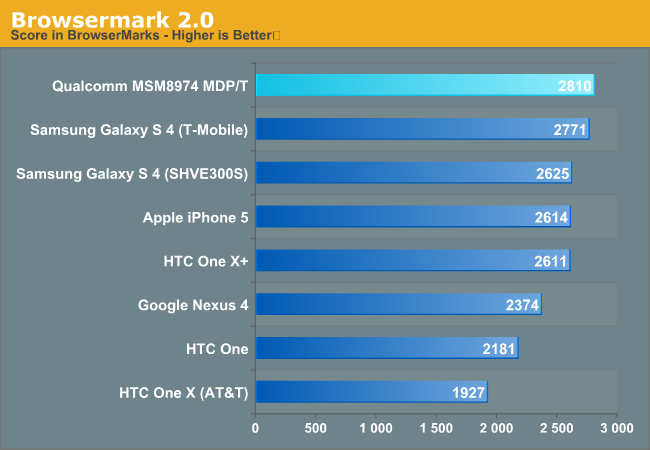
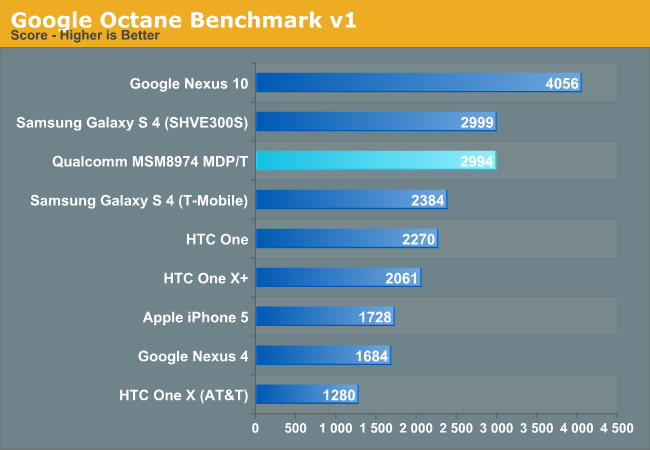
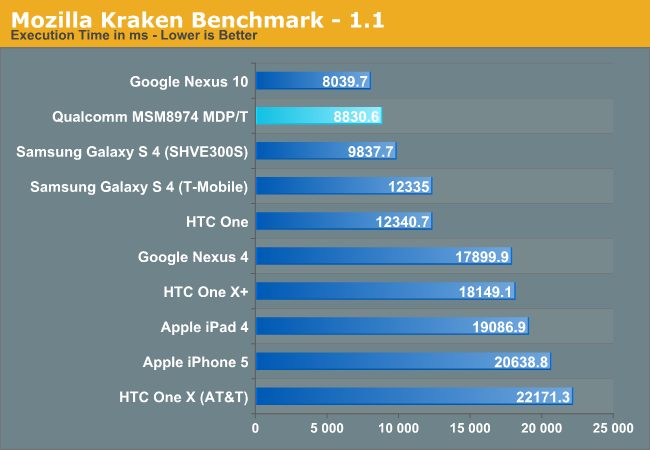

Krait 400 seems to do very well against ARM's Cortex A15, trading positions in terms of performance depending on the test. As these are browser based benchmarks there's a big software component to variability that prevents big conclusions from being made here, but it's clear that Snapdragon 800 is in a similar performance class to current Cortex A15 based designs.
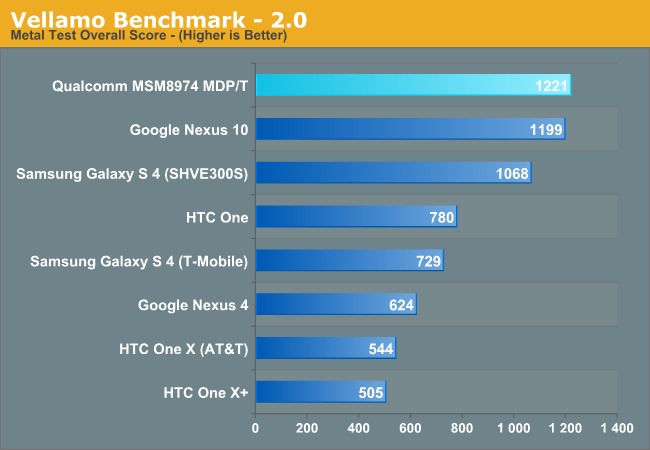
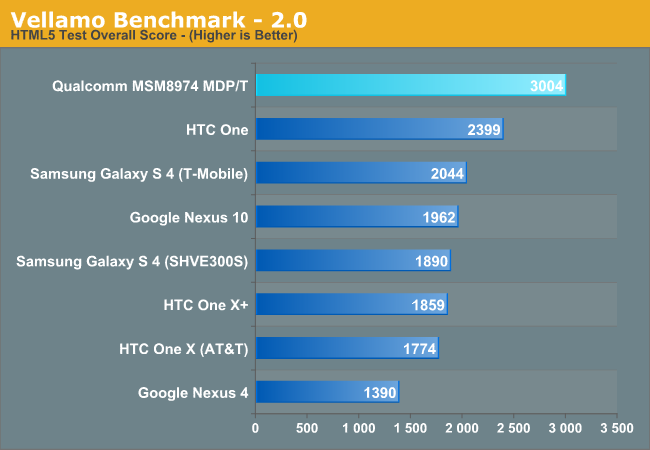
AndEBench
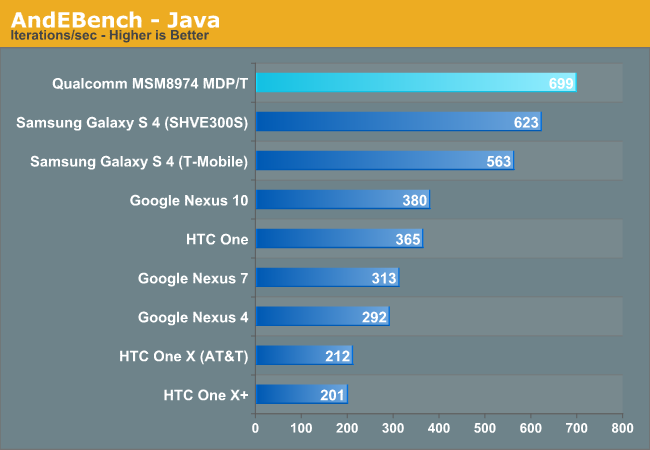
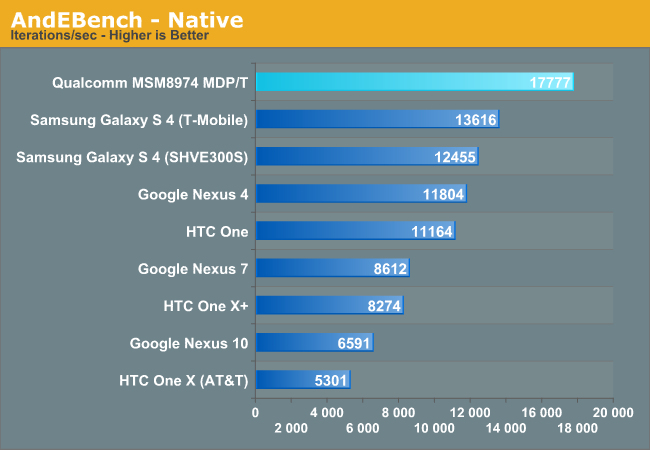
The Java and Native client AndEBench tests echo what we've seen elsewhere: Snapdragon 800 can definitely be quicker than ARM's Cortex A15, and at least is in a similar class.










115 Comments
View All Comments
Kurge - Wednesday, June 19, 2013 - link
Yeah.. no. Saltwell is a 2 core, in-order processor.Silvermont is a completely different beast - 4 real, out of order cores.
I _do_ expect Silvermont to come close to A15 and in fact go well beyond.
Wilco1 - Wednesday, June 19, 2013 - link
Why would you expect that? Silvermont is just a 2-way limited OoO core, very similar to Cortex-A9. Cortex-A15 on the other hand is very aggressive with a large reordering window, 3-way and supports 2 memory accesses per cycle (vs just 1 for SilverMont). Given that it should be obvious Silvermont will have a lower IPC than Cortex-A15.You'll be disappointed. Even Intel is claiming just a 2.8 speedup with double the cores and a 20% clock boost. So at the same core count and frequency the speedup from Silvermont is only 16%...
ncp - Wednesday, June 19, 2013 - link
Qualcomm will probably keep the power low as they are cheating on benchmarks.They are detecting what application is launched. For a given list of benchmarks they are tweaking CPU governor to go to full power, tweak data base access and anything yet uncovered.
This way they got very competitive scores on known benchmarks.
This is somewhat smart, however other competitor (IC maker) don't do that so get scores more inline with the way the device is configured in order to get a good pert/power compromise.
Some phone makers are also cheating on top of Qualcomm Cheating, at least one.
Note that probably many phone makers using Qualcomm chipset even do not realize they are cheating on behalf of Qualcomm.
krumme - Wednesday, June 19, 2013 - link
Does that include the "at least one" cheating on top of Qualcomm?Wilco1 - Wednesday, June 19, 2013 - link
In what way is setting the CPU governor cheating? You won't get a better score than the maximum possible score, you'll just get it first time. It seems there is far worse cheating going on with eg. Atoms AnTuTu scores, which are impossibly high (A15 has 3 times faster Stream scores and yet less than half the memory score in AnTuTu?!?).qwerty12345 - Friday, June 21, 2013 - link
looks like wilco1 is a paid pro-qcomm and anti-intc talking machineLaststop311 - Wednesday, June 19, 2013 - link
oh man once we hit 14nm soc arm designs we are gonna have insane performance.FramePointer - Wednesday, June 19, 2013 - link
You're naive if you believe you can accurately estimate the performance of Silvermont based on high level architectural details like the ones you have provided. Given how the current generation of Atom is still using in order execution it should be no match to Qualcomm's Krait or even a basic Cortex A9 (which has at least limited OOO execution) if we were using your logic. Anandtech's own analysis has shown that this is not the case at all."Silvermont is just a 2-way limited OoO core, very similar to Cortex-A9. "
And yet even Clovertrail+ crushes the ARM A9 and it is older than Silvermont.
Wilco1 - Thursday, June 20, 2013 - link
Yes you can make accurate predictions based on the microarchitecture, I've got the experience and patents to make that statement. A9 typically crushes much higher clocked Atoms, eg. http://browser.primatelabs.com/geekbench2/compare/... Both are 4 threads btw, so it is a fair comparison, however a 1.6GHz A9 beats a 2GHz Atom on most single threaded benchmarks as well. Again this is entirely expected based on their respective microarchitectures.Anand's analysis is not believable given he only ever runs JavaScript benchmarks, and these are highly dependent on the browser used. Even on the same hardware there are huge variations. To give an example, the S4 Octa scores 679 on SunSpider according to FoneArena, but Anand claims 920 above. That's a huge difference on the same phone - who is right? The 679 number is correct as that is close to what the Exynos 5250 scores in the Chromebook. So until Anand cleans up his benchmarking I would take his scores with a bag of salt.
shodanshok - Thursday, June 20, 2013 - link
If you think that a single A9 core can beat and destroy a single Atom core, you are wrong.From Anand's iPad2 review:
Alongside multitasking is the performance problem. With the original iPad even deleting several emails at a time was a bit choppy, and web page rendering performance needed tons of work. As always Apple does its best to hide the limitations of the platform but I must point out that even the iPad 2 with a pair of ARM Cortex A9s has lower CPU performance than a netbook with a single core Atom. The fact that you can't really tell most of the time is a testament to Apple's software engineering, but it doesn't change reality.
Some more benchmark:
Tegra 250 @ 1.0 GHz
Core: 2
Compiler: GCC 4.4.5
Coremark/MHz: 5,148
Total Score: 5148,01
Threads: 4
Flags: -O3 -funroll-loop -falign=8 -mcpu=cortex-a9 -mfpu=vfpv3-d16 -mfloat-abi=soft
Atom N280 @ 1.68 GHz
Core: 1
Compiler: GCC 4.4.4
Coremark/MHz: 3,187
Total Score: 5353,79
As you can see, _2_ A9 cores nave total throughput equal to a single Atom core. Atom need high clock of curse, bit it was a specific architectural choice from the start.
The truth is that only A15 decisively defeat Atom.
Unfortunely, Atom GPU was really terrible, being crushed by all others.